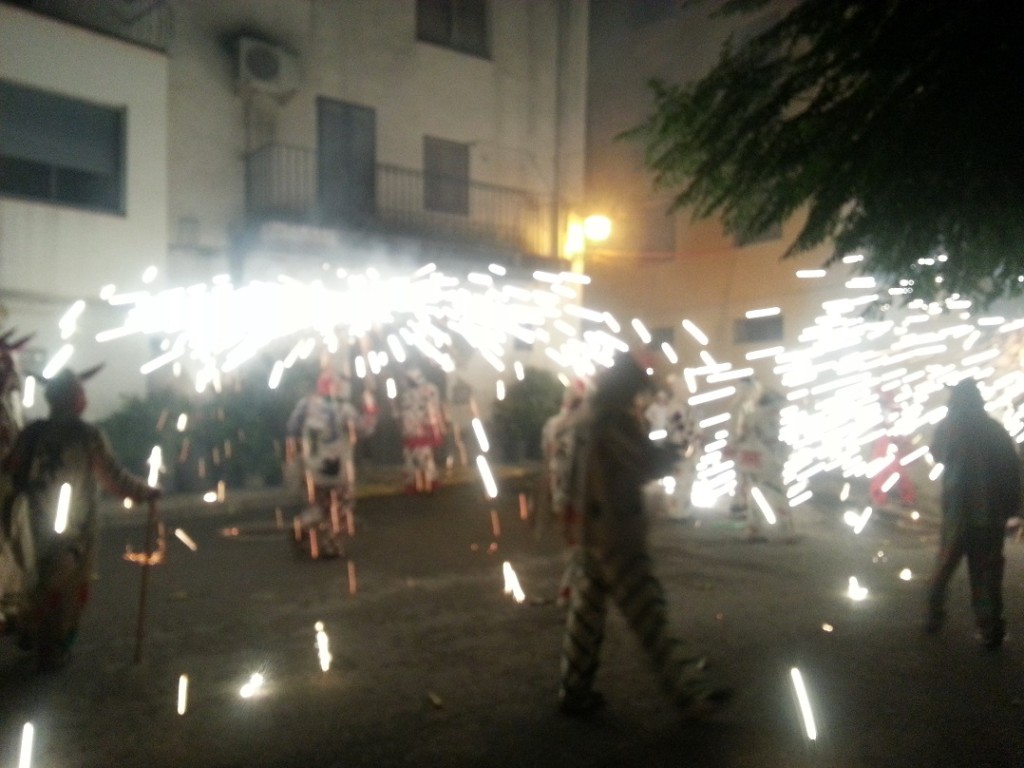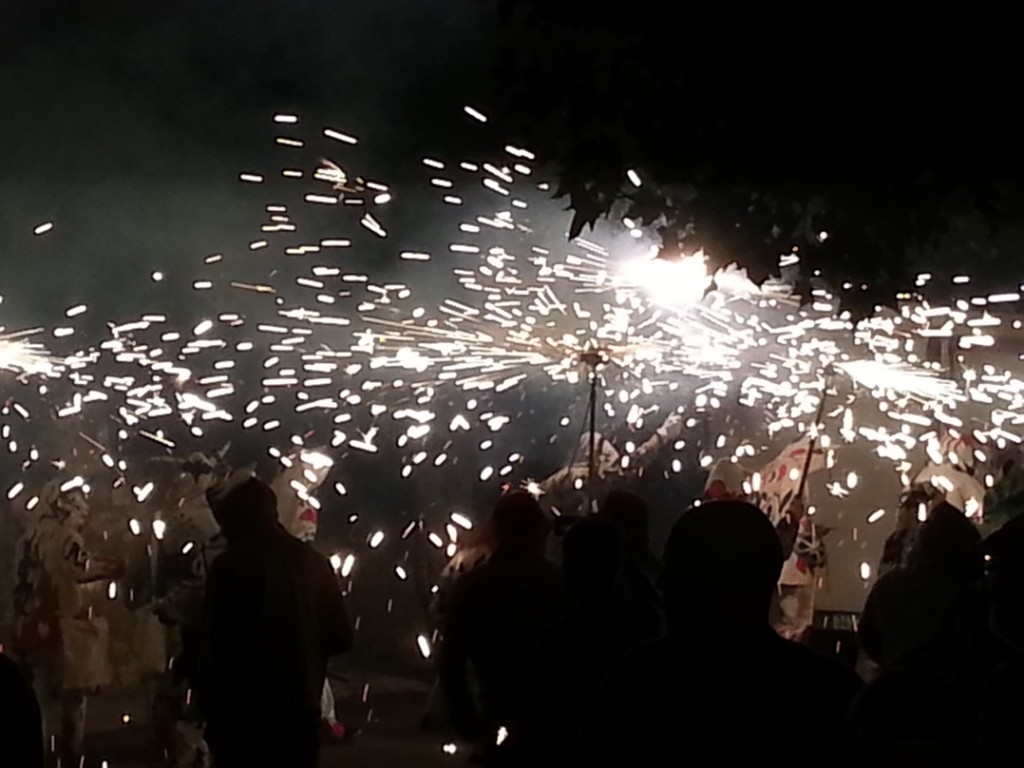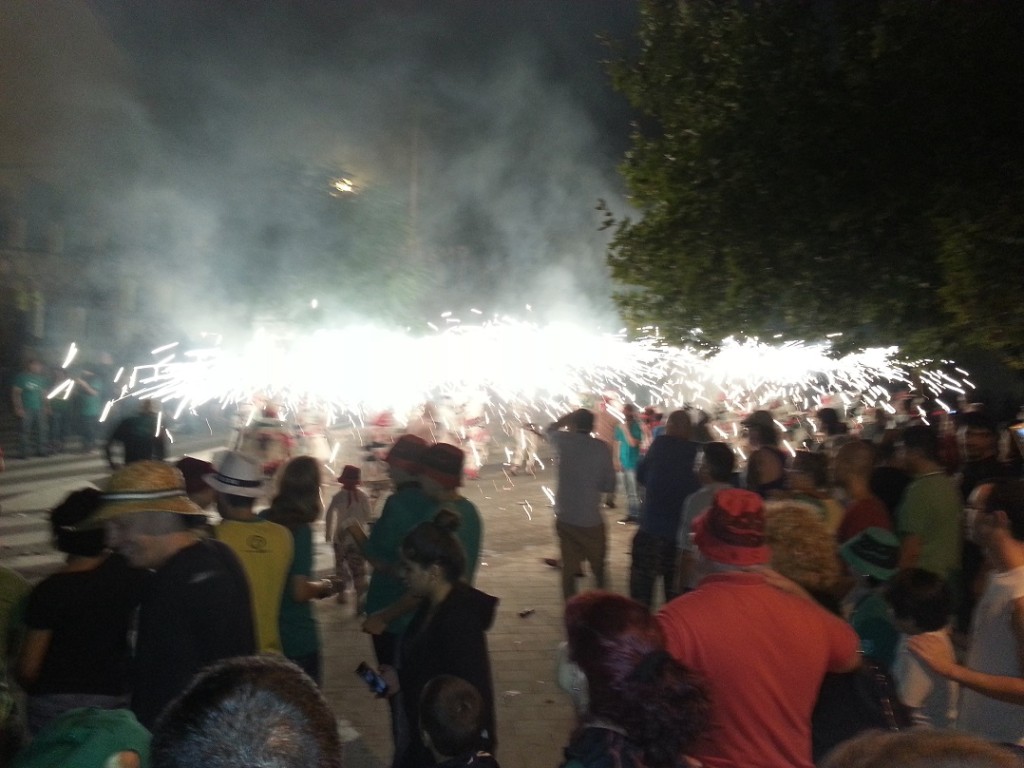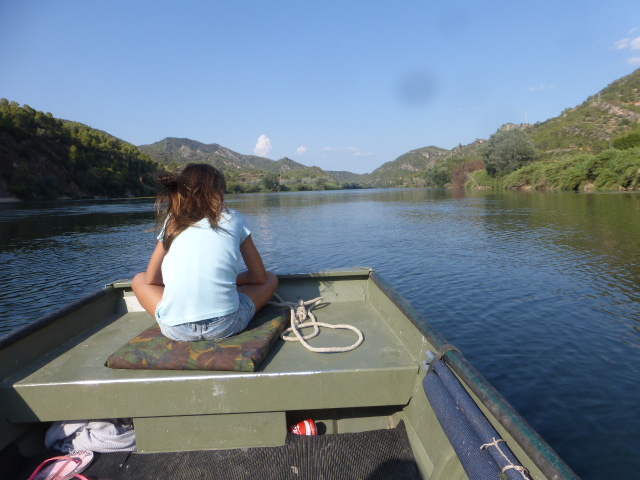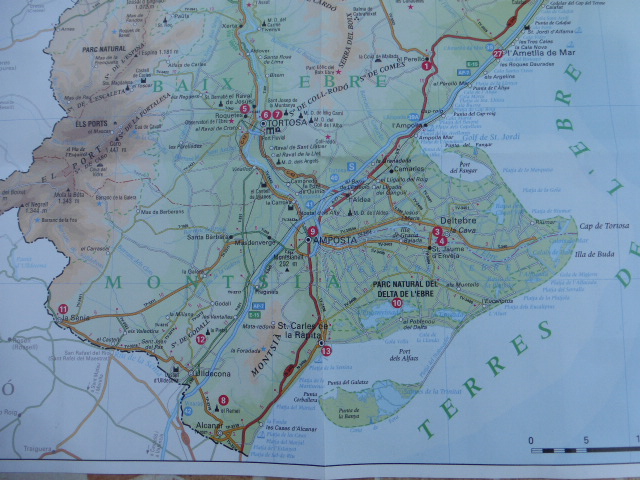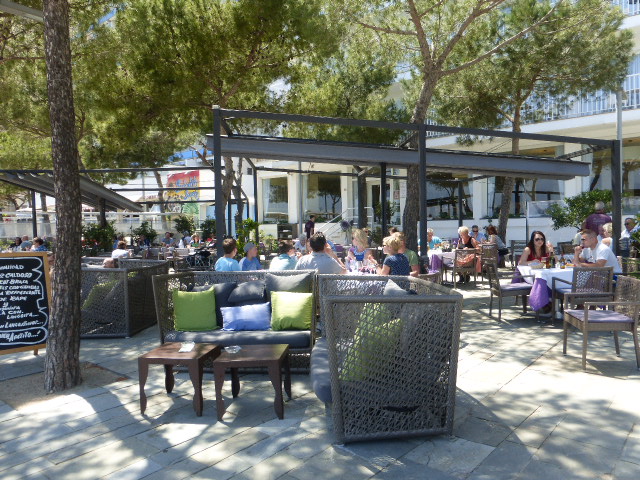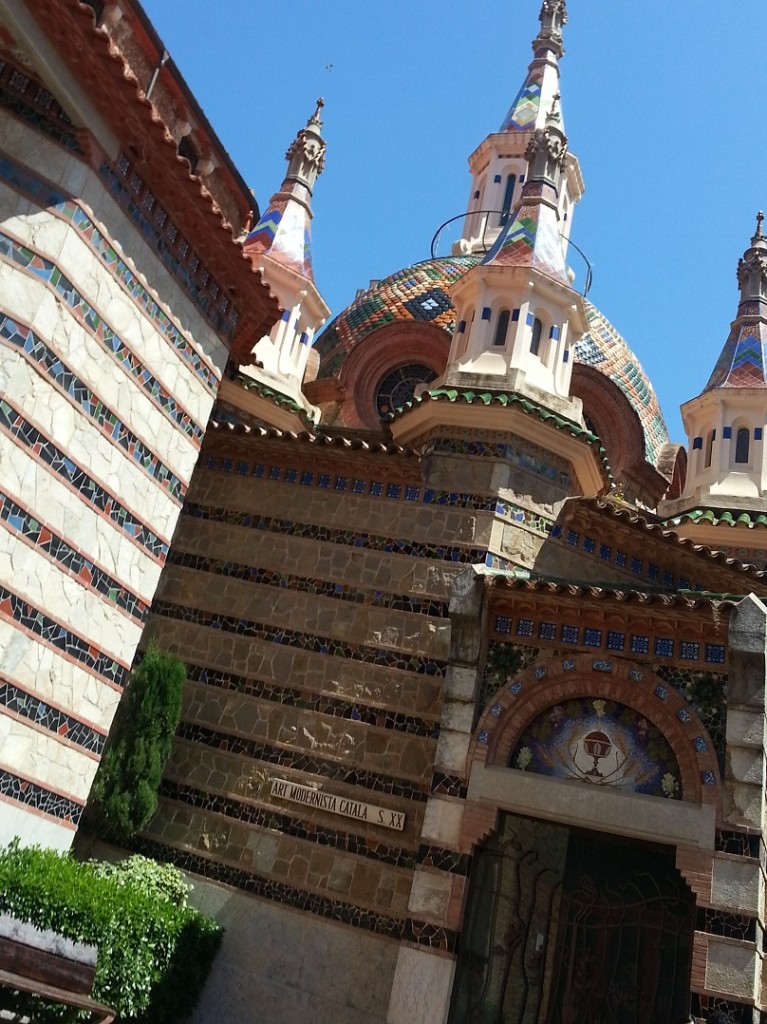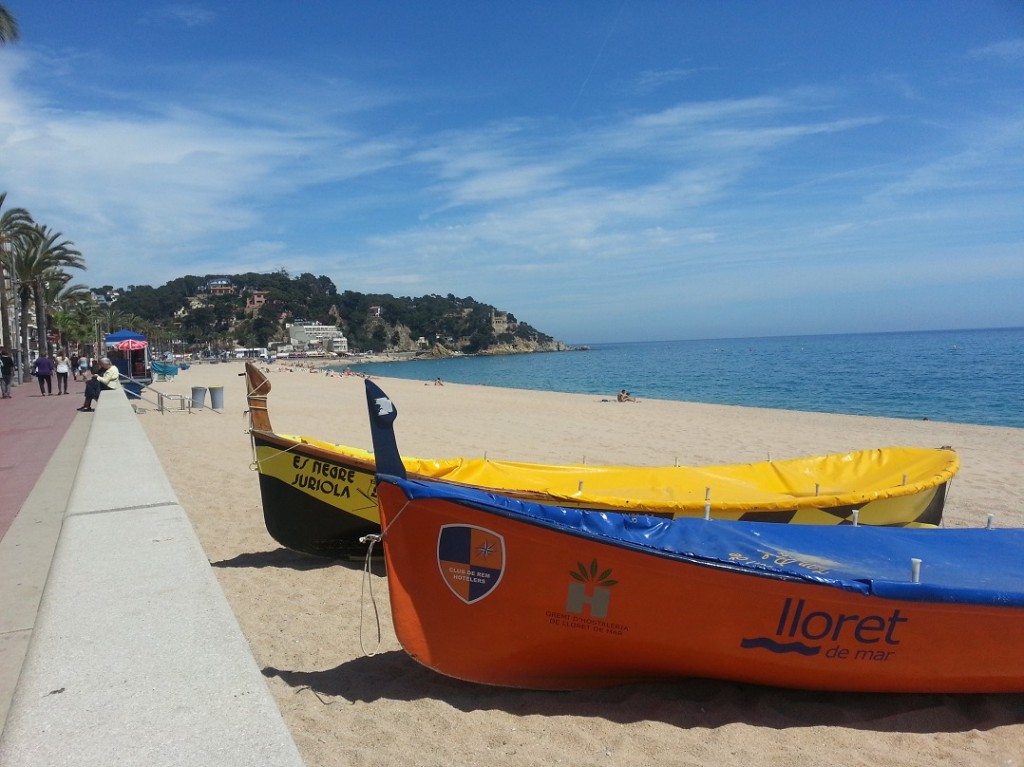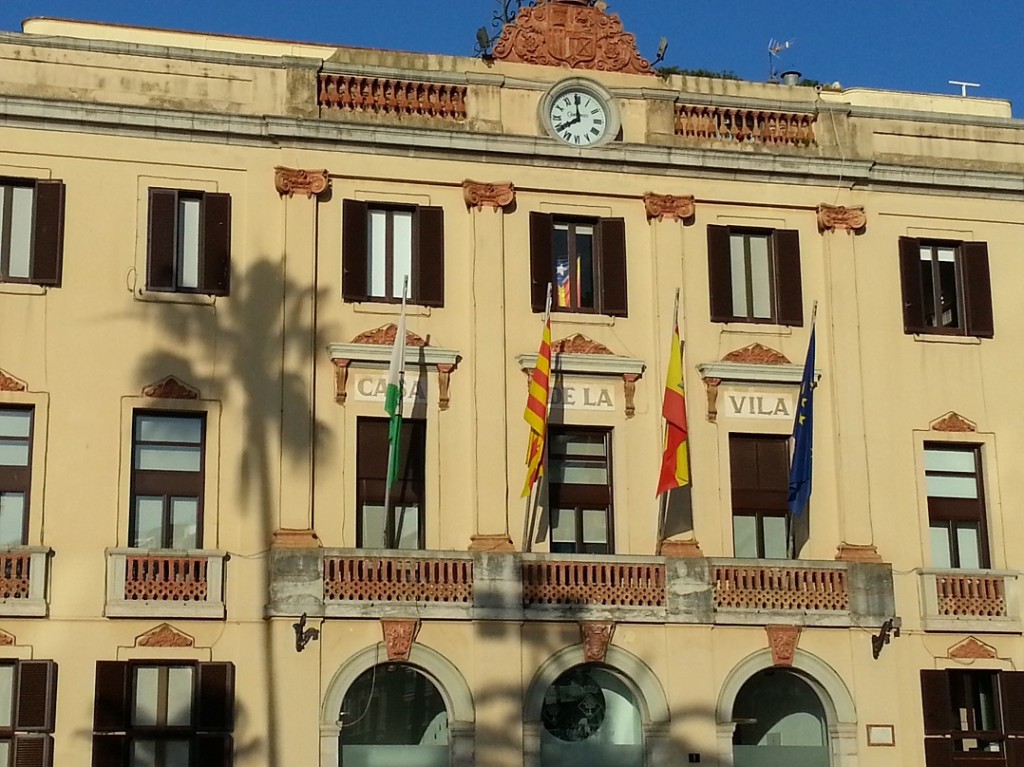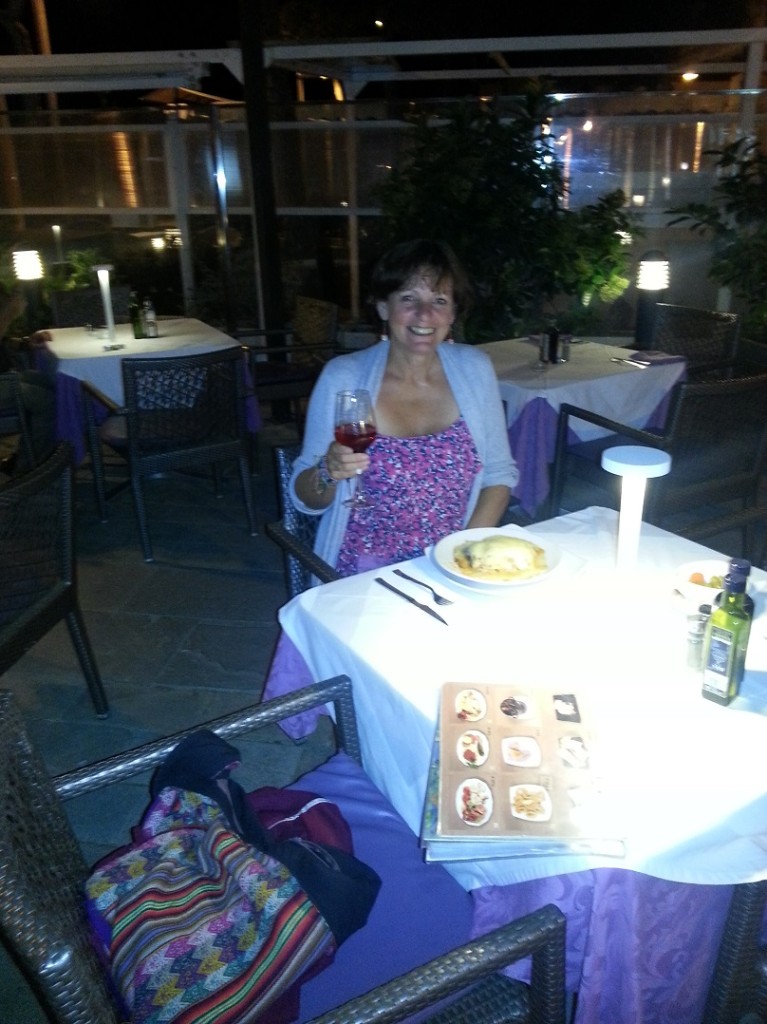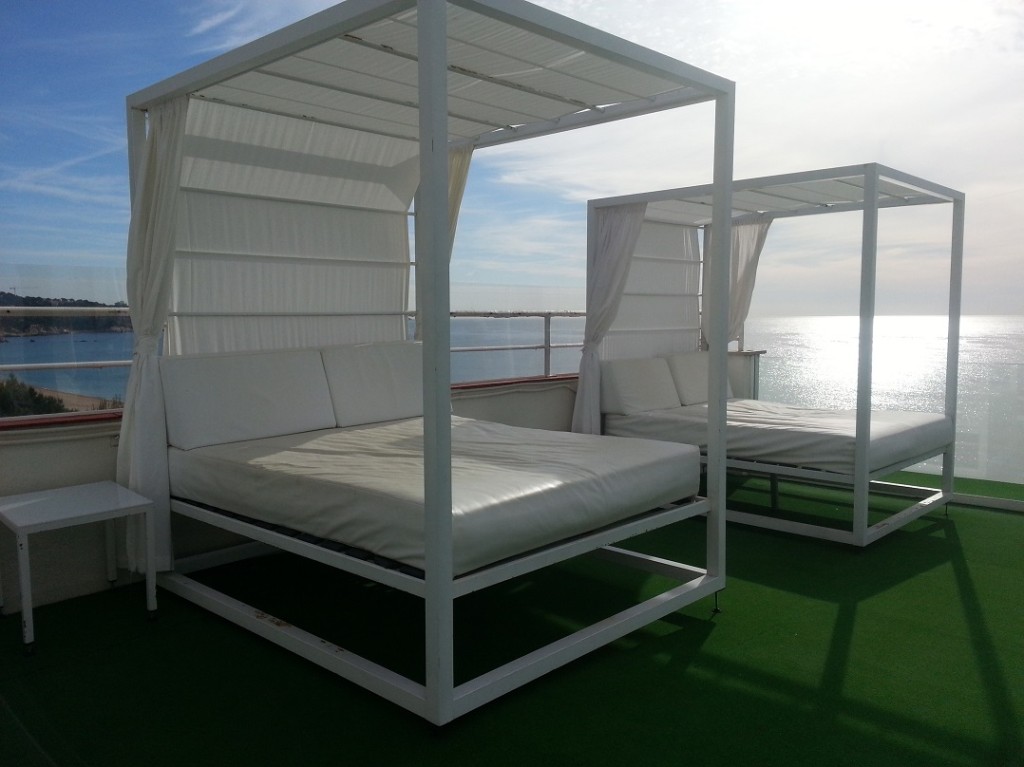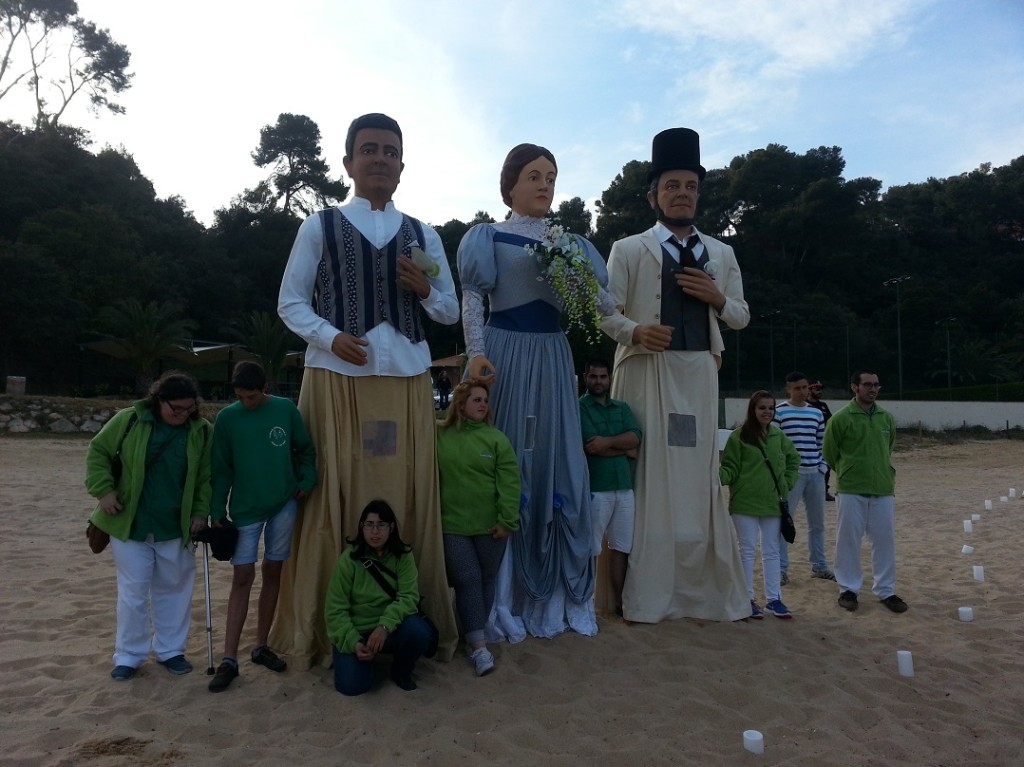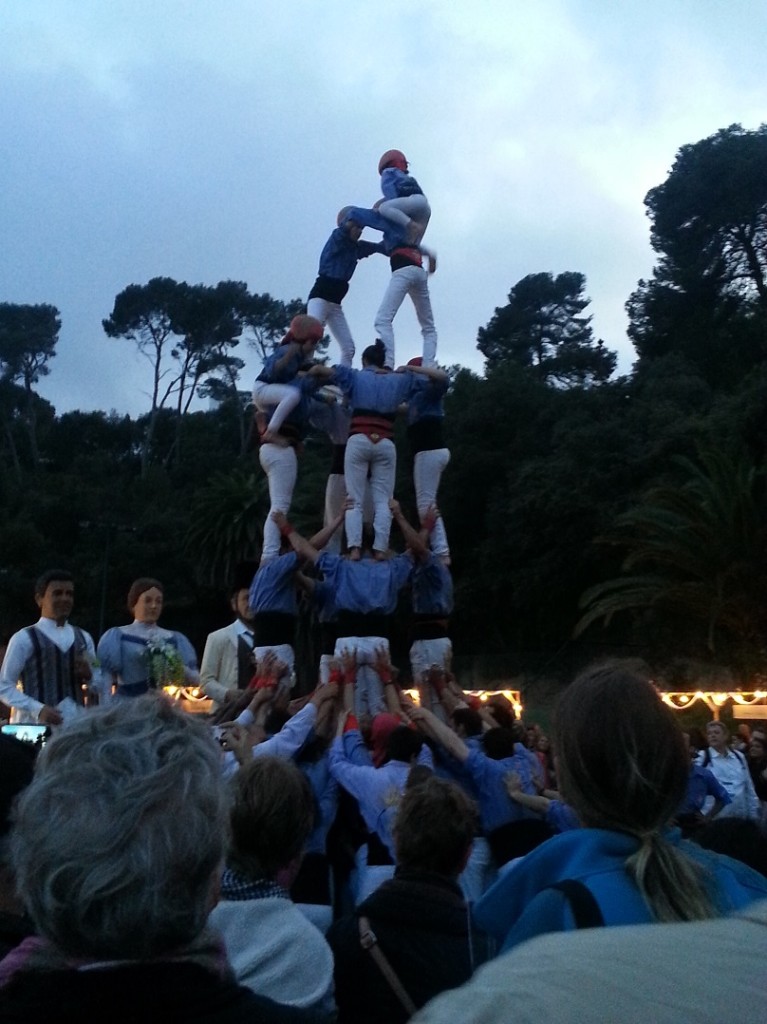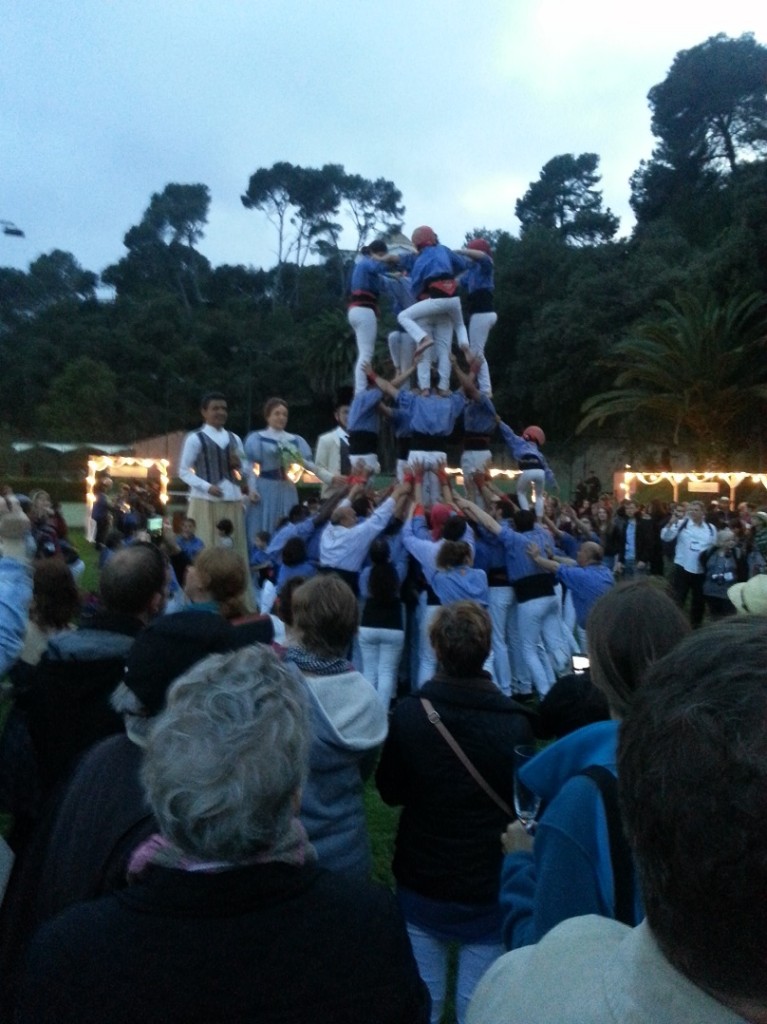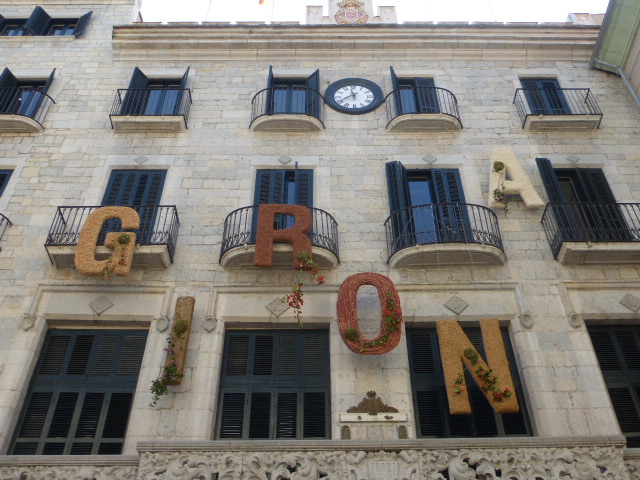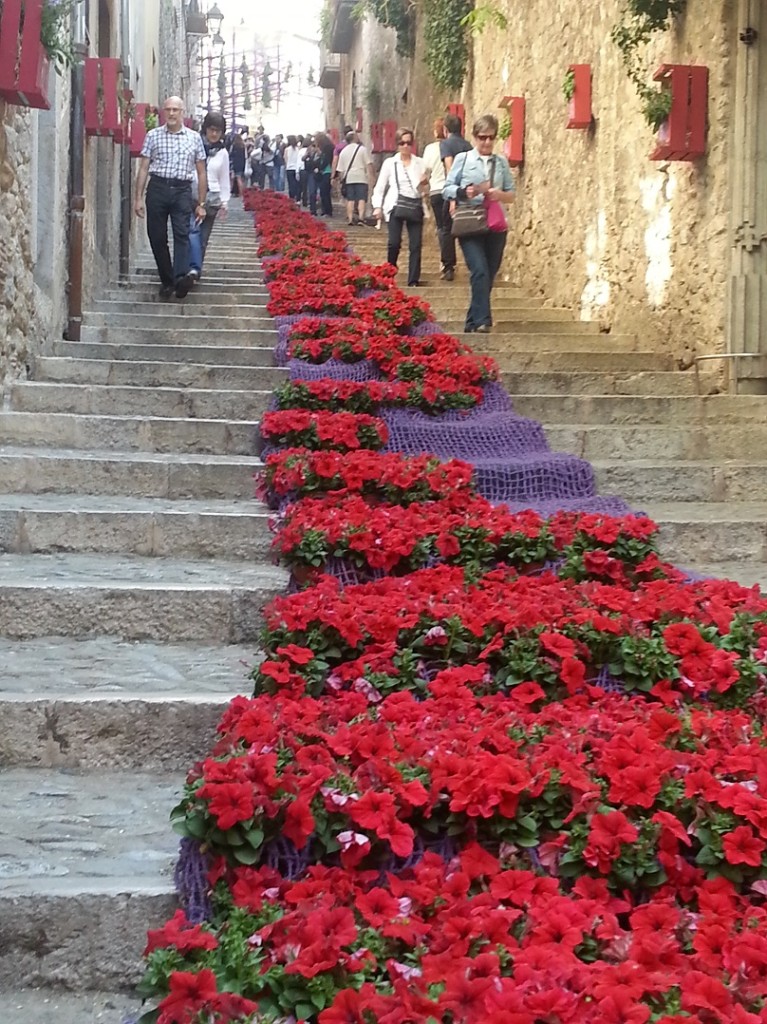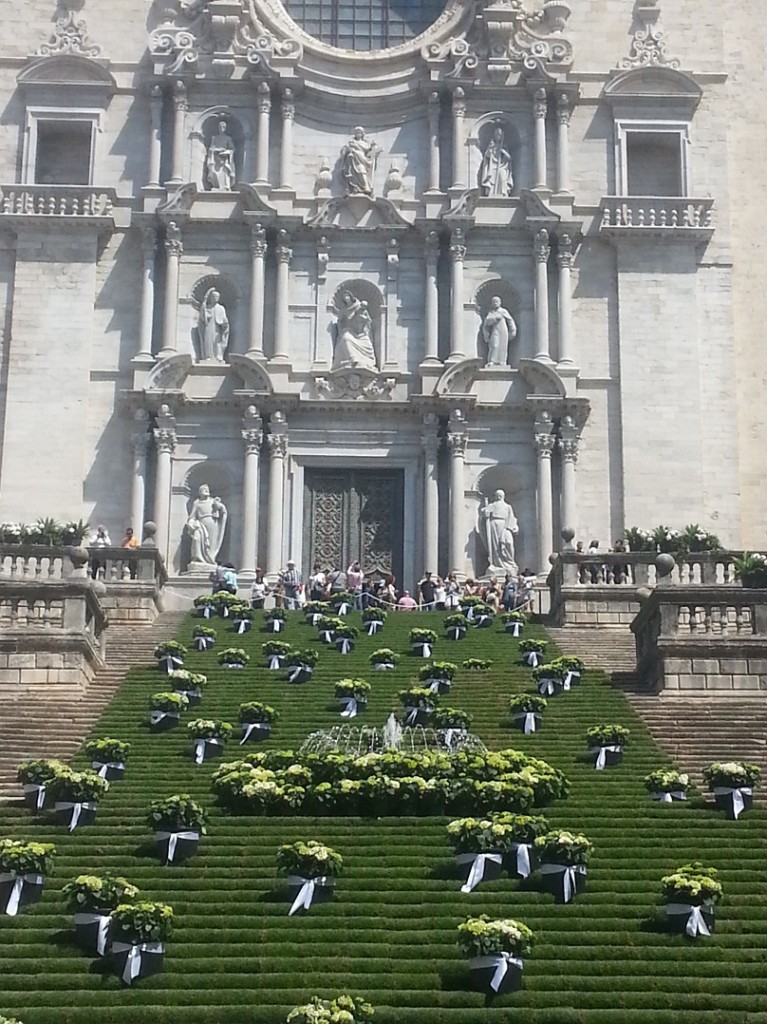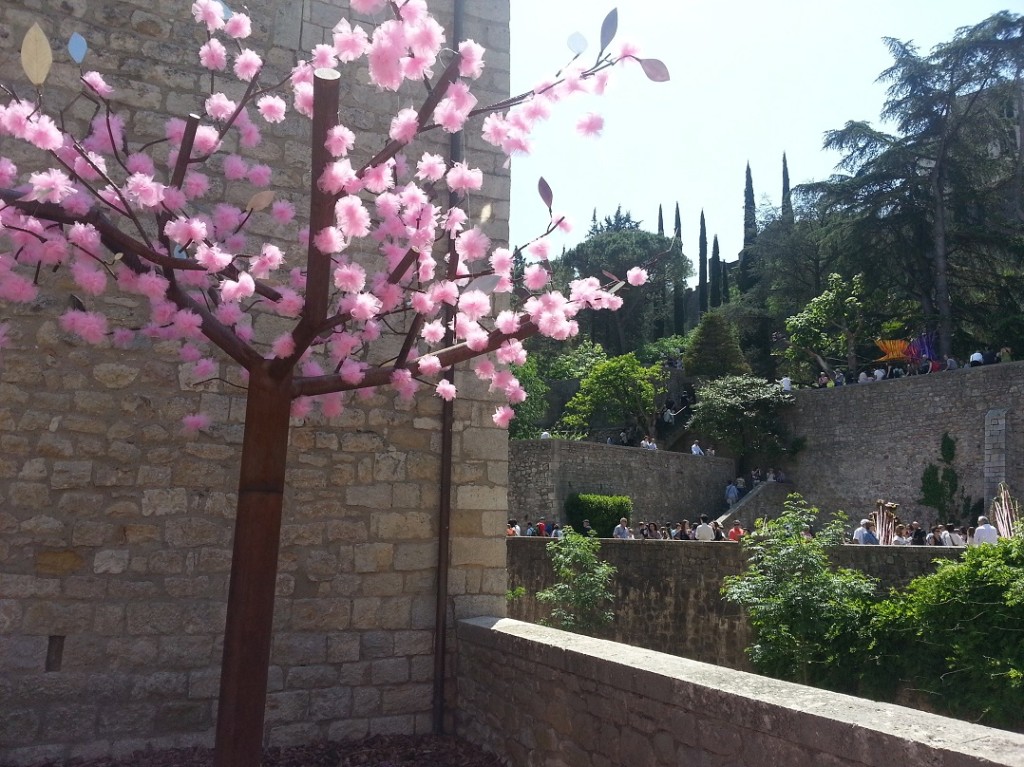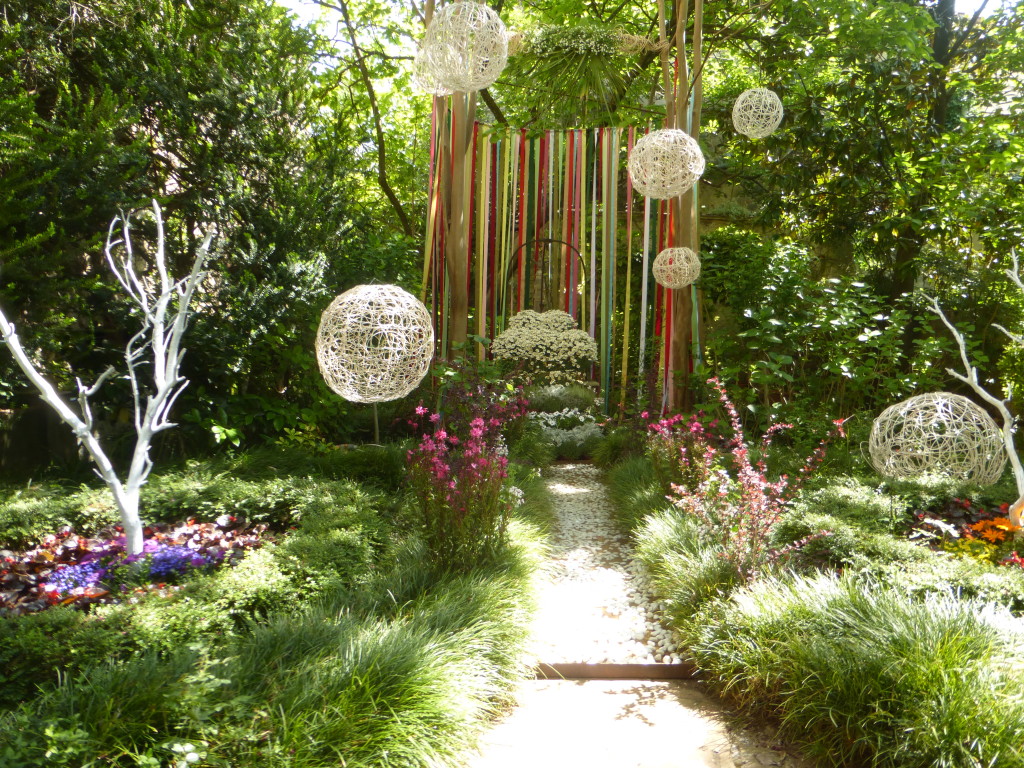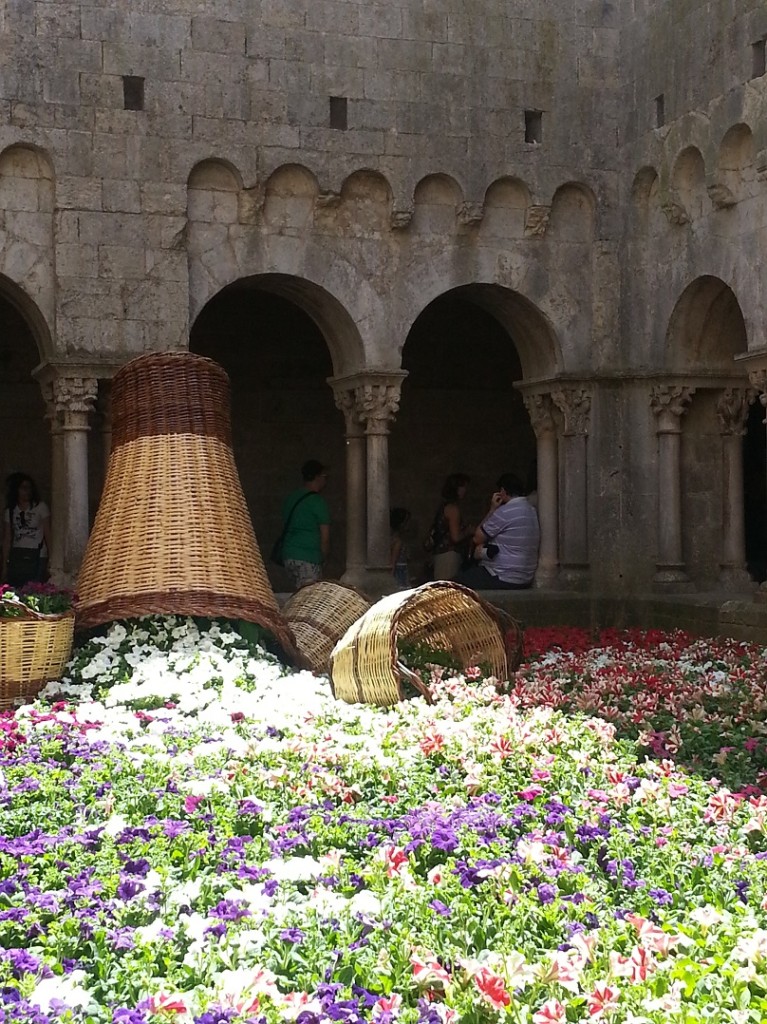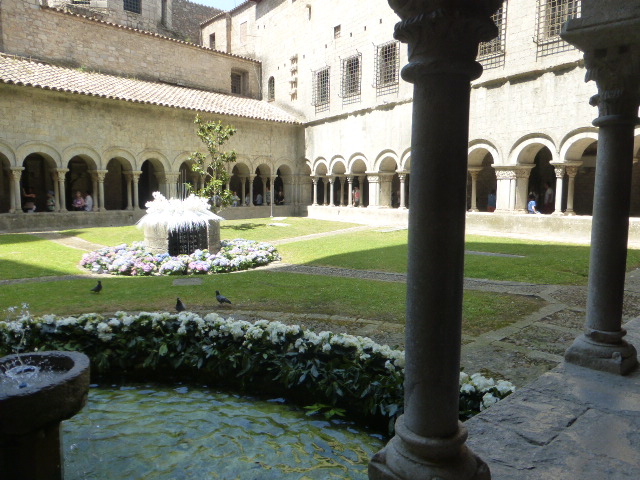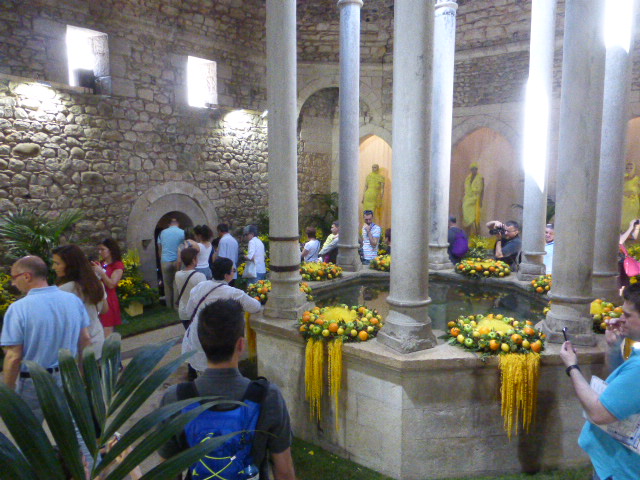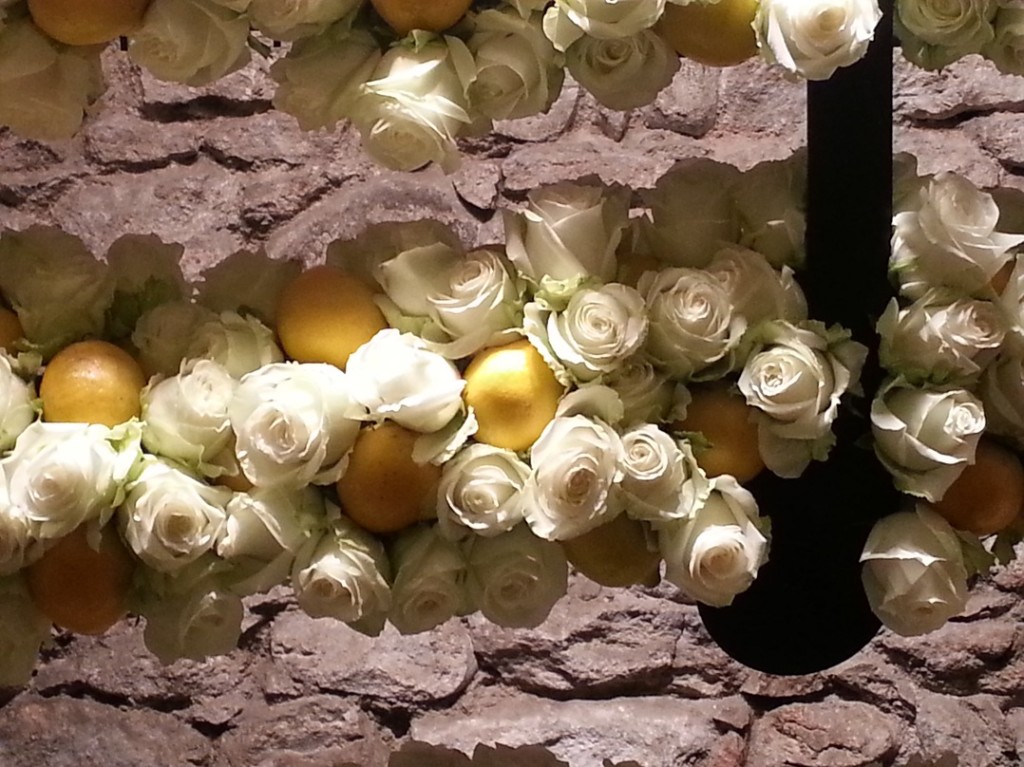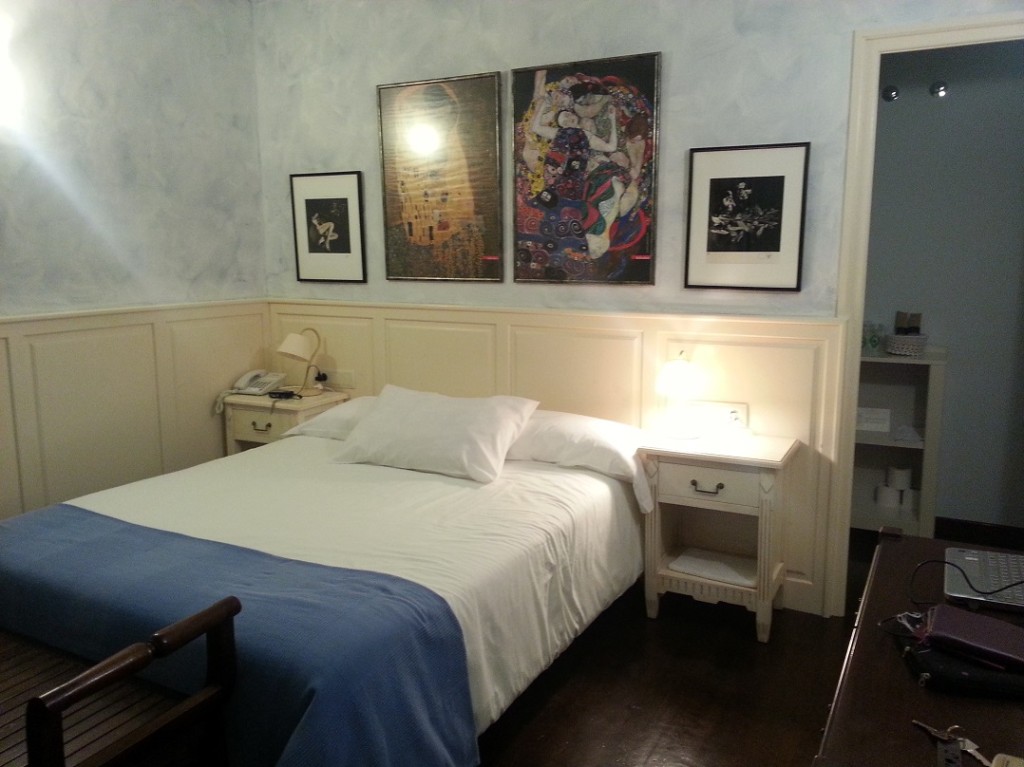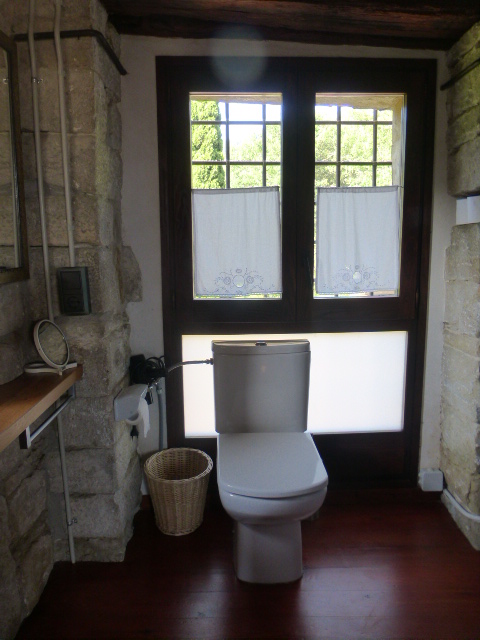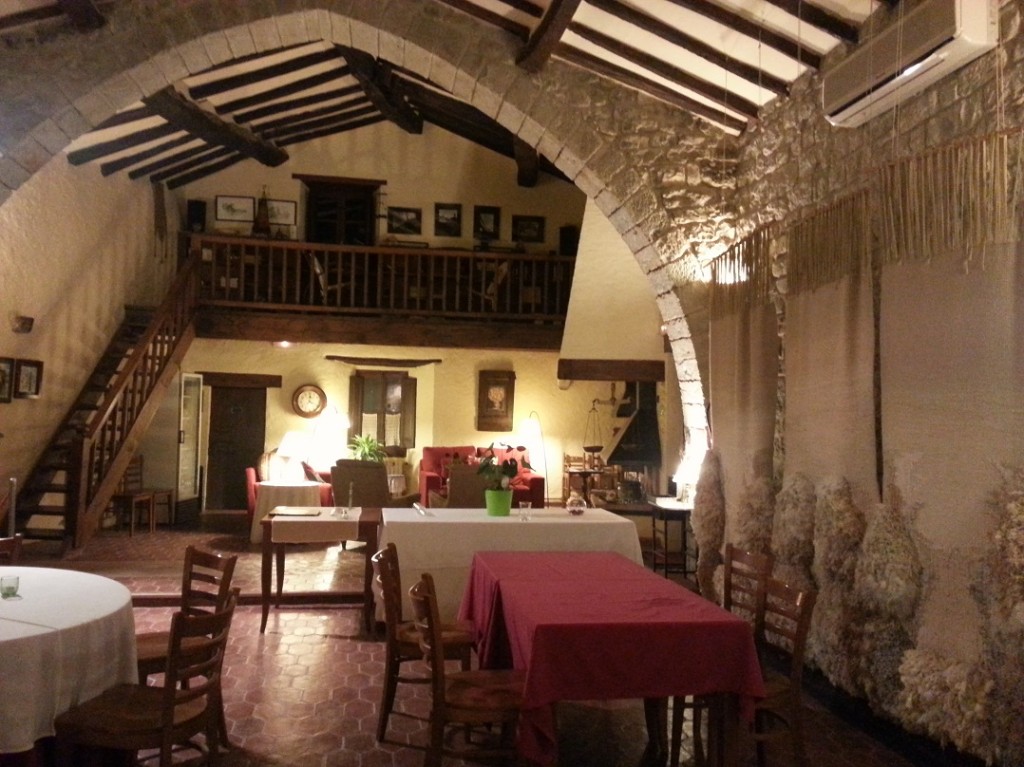
by Jane | Sep 1, 2015 | Europe |
What is a Correfoc?
The Correfoc is a Catalan fiesta which translates as Fire Run and it’s certainly not an event for the faint-hearted or for those of a nervous disposition!

parading in the narrow streets
The ‘colles de diables‘ or groups of devils wear costumes decorated with intricate designs, all slightly different and I would imagine costing quite a bit of money to make. Others wear capes and evil looking devil masks and they all parade in the dark accompanied by groups of drummers who beat out a steady refrain.
The ‘devils’ move to the beat in a shuffley sort of a dance and they carry pitchforks or frameworks like big chandeliers above their heads with spitting, spinning roman candles mounted on top of them and then the devils dash towards the crowds spraying bystanders with sparks. As the fireworks burn out they blast high into the air with loud bangs and the night is filled with smoke and the smell of gunpowder.

posing before it gets dark
The dancing devils are accompanied by men in dragon costumes who have fireworks attached to the dragons’ backs and who snort fire at everybody as they weave their way along the streets of the towns and the villages.
I took part in a Correfoc fiesta in a little Catalan mountain town, where the narrow cobbled streets echoed and crashed with noise and there was nowhere to run. Cowering under trees then dashing forwards when there was clear space, we followed the procession – fire running – to the square in front of the church where the devils regrouped and doused themselves with water, before returning along a different route for their amazing finale.

the Correfoc is quite a spectacle
The whole time, children nip in and out and taunt the devils, wearing their own miniature versions of the costumes, complete with scarfs, hats and fireproof gloves and they are also dampened down at regular intervals.
Background to the fiesta
Surprisingly the Correfoc is not an ancient tradition but it was resurrected after Franco’s rule as a way of establishing a Catalan identity. Sadly, the EU are doing their best to regiment the events which they claim are dangerous and are trying to ban it or at least turn it into a sanitized show piece with no audience participation.
Yes, it can be dangerous. Yes, there was a big queue waiting for their injuries to be dressed at the ambulance station. Yes it was scary but wow, what an experience.
If you are going to attend a Correfoc dress accordingly – wear old clothes and cover your hair, and as for the Health and Safety mob – well, if you are worried, stay at home.
The finale
As the procession reached its finale, all the participants crowded together, tightly packed into the square. The drumming became more frenzied and everybody crouched low and then jumped up in a ritual dance and then, in a last blast, all of the hoses were lit and night became day.
Our fiesta went on for nearly two hours and I don’t think that my pulse stopped racing at all. I don’t know when I have ever sustained such an adrenaline rush for such a long period of time. I do know that I was grinning as wildly at the end as I was at the start once I realised that I was probably not going to get burnt to a cinder.
Would I go again? You bet!

gunpowder and smoke

by Jane | Aug 11, 2015 | Europe |
When I was in Catalunya I was offered the chance to go cat fishing on the River Ebro.
Click here to read about my experience
A week later when I was chatting to a random man on the Metro (as I tend to do) and asked what cat fishing was, the word association prompted me to reply ‘fishing for cats’. Both of us were covered with confusion.
Me – because I knew that I had obviously made a verbal boob
Him – he was obviously wrestling with the thought of my fishing for fluffy kittens and wondering perhaps how wise it was to talk to complete strangers that sat next to him on the train.
You can read my article here – Top Cat Fishing in Catalunya – and find out whether I caught any fish – or indeed – any fluffy little kittens

Waiting for a bite

by Jane | Jul 7, 2015 | Europe |
My time in Catalunya, Spain has been spent in some diverse places. I have climbed mountains and I have relaxed on beaches. I have eaten countless tapas from the smallest backstreet bars and I have dined in a Michelin Star restaurant.
Contrasting totally with all of my experiences so far in Catalunya, I explored the Ebro (or the Ebre to give it the Catalan spelling) delta.
Read more here about the flamingos, the sunrise and the paddy fields

the boardwalk on one of long beaches

by Jane | Jun 23, 2015 | Europe |
Do you remember the Spanish beach resorts? Maybe it’s time that you revisited them
The beach resorts of Lloret de Mar and Platja d’Aro
The Spanish beach resorts attract millions of tourists every year. Visitor numbers are influenced by the global economic situation, the success and popularity of other destinations and the reputation of the resorts within different groups. Back in the 80’s this coastline began to attract hoards of young holiday makers (sadly the Brits were tarred with a bad reputation although they were no way alone) – the 18-30 set who were hell-bent on getting drunk, sunburnt and sleeping with as many strangers as possible. Many of the resorts attracted large ex-pat communities who wanted a cheaper cost of living, or elderly visitors who were looking for winter sun so there was this curious disparity between what people were hoping to get from the area. When I last visited the holiday resorts of Spain the bars and restaurants screamed ‘Irish Pub’ or ‘British Fish & Chips’. Karaoke bars, full English breakfasts and bar crawls were the name of the day. Those things are still there but there has been a not-so-subtle change.

Santa Roma, Lloret de Mar
The resorts have reinvented themselves. They have dragged themselves kicking and screaming into the twenty-first century. Progress and modernity go side by side with culture, history and, in the case of Catalunya, a pride and a desire to reclaim their own specific culture and separate identity.

The beach at Lloret de Mar
Streets have been pedestrianised, museums and experience centres have been revamped and there is a greater emphasis on a more wholesome experience. Regional cuisine across Spain is generally excellent and international dishes can be found just about everywhere. There is a big emphasis on fish and seafood and all over the country you will find many of the restaurants offering a ‘Menu del Dia’ during the weekday lunch times. This usually consists of 2 or 3 courses of food plus a drink at a very reasonable price and is extremely popular among the Spanish who treat lunch time with a special reverence and certainly do not rush the meal.
Lloret de Mar
One of the gems of Lloret de Mar is its old town district with narrow streets lined with shops and little bars and restaurants where chairs and tables spill out into the sunshine. A wide promenade backs the beach and the coastal footpath winds its way away from the town and across the cliffs in both directions. High on one of the cliffs is a monument to the fishermens’ wives, watching out to sea.

statue to the fishermens’ wives
These days Lloret de Mar is establishing itself as an activity resort both on the water and off. Yes, there are still bars and clubs and a wild side but there is another side to Lloret, a side which appeals to hikers and kayakers, climbers and cyclists. Defined as an ‘urban beach’ tourist destination, the natural attractions are complimented by additional activities and attractions. The town appears affluent because of the money which was initially invested into it by the Indianos or Americanos. Boatloads of (mainly poor) teenage boys and young men left for Cuba and America in the early 1800s and made their fortunes, mainly in the boat building industries. They returned with their wealth to marry and to settle in Lloret de Mar, constructing grand villas and houses.  This link to foreign lands is also reflected in the modernist cemetery and the rather grand Church of Sant Roma with its domes and mosaics. There are the beautiful cliff top gardens of Santa Clotilda, a comprehensive maritime museum and the Castle of St Joan which watches over the town from its position on the cliffs. There are 13 beaches and coves in the immediate vicinity of the town where you can toast yourself in the sun to your heart’s content whilst if you want to go sightseeing the town has good transport networks to the surrounding towns and Barcelona.
This link to foreign lands is also reflected in the modernist cemetery and the rather grand Church of Sant Roma with its domes and mosaics. There are the beautiful cliff top gardens of Santa Clotilda, a comprehensive maritime museum and the Castle of St Joan which watches over the town from its position on the cliffs. There are 13 beaches and coves in the immediate vicinity of the town where you can toast yourself in the sun to your heart’s content whilst if you want to go sightseeing the town has good transport networks to the surrounding towns and Barcelona.
Platja d’Aro
Further up the coast from Lloret de Mar is Platja d’Aro which has a long sandy beach backed by a pleasant promenade and which is lined with hotels, apartments, restaurants and beach bars. When I was there the sand sculptors were out creating intricate designs from wet sand for an exhibition and the smell of paint was in the air as the bars and cafes prepared themselves for the summer season. But due to the climate and some very clever marketing, Plaja d’Aro has something for everyone all the year around. It’s also very close to the historic city of Girona with good bus links and it has countless shops and little malls which sell everything that you can think of.

Sand art at Platja d’Aro
Wide pavements and large open spaces as well as the huge stretch of beach, coupled with not too many overly high buildings give the resort an upmarket feel, and what was striking, along with the other places in the region that I visited was the cleanliness and attention to detail which is reflected in the smart paving stones and the eye-catching signs which hang outside the various businesses.
The Hotel Planamar
I was fortunate to stay at the Hotel Planamar which is set right on the beach at Platja d’Aro. It is just a couple of streets back from the main road and a short hop from all of the major shops and bars, but due to its position is nice and quiet at night.

Hotel Planamar, Platja d’Aro
I was pleasantly surprised when I saw my room which was very different to the standard hotel rooms that I remembered from the ‘nineties. The bed was in the centre of the room facing the balcony and behind a small wall was hanging space, a washbasin, a fridge and a large, walk-in shower with constantly changing coloured mood lights. The toilet had a frosted glass door which was a bit bizarre but it did give the impression of light and space. I had a TV, a balcony (with a sea view), good free WIFI and a welcome touch of a complimentary bottle of wine.

My room. Not huge but perfect
I stayed at the Hotel Planamar for 6 nights and breakfast was included during my stay. Breakfast was served buffet style in the comfortable restaurant which overlooked the beach and there was a great selection of hot and cold foods, cereals, fruit, toast and excellent coffee. Lunch and evening meals are available here too and must have been good because the restaurant was always busy. Below the hotel was a bar where I saw a lively flamenco show one evening and on another night they hosted a musical duo. The bar also serviced the beach restaurant where food was competitively priced. One night I dined by candlelight and ate a tasty lasagne and wine – feeling like Shirley Valentine as I gazed out to sea and I was periodically chatted to by the attentive waiters and bar staff.

Shirley Valentine – the beach is behind me
The rooftop pool and terraces have also been given an upmarket, modern twist. Large double four-poster sun beds add a touch of glamour and there is a small gym inside a glass cube room with views out over the bay. You can arrange to have a massage or a manicure and the swimming pool is inviting.

Relax in style at the Hotel Planamar
On the ground floor of the hotel there is a comfortable reading area with a TV and a comprehensive library of books to borrow or swap, there is a computer available for guests and a couple of tables and chairs outside by the front door if you want to sit and watch the world go by.

you don’t feel swamped by the tall buildings when you are at the hotel
The staff are very friendly, speak many languages between them, and they will make sure that you have no problems.During my stay the majority of the visitors were from France and there was also a contingent in for the Grand Prix in Barcelona.
Oversized puppets and human towers
Before I finish telling you about this region you may be interested in the gigantes and the castellers.  Whilst not confined to Catalunya the gigantes are massive puppets styled as people. If you are of a certain age you may remember the British game show ‘It’s a Knockout and the hilarious costumes? Well they were styled on the gigantes. The figures can be several metres tall with giant papier mache heads and elaborate clothing. They are operated from within by a person who ‘wears’ them on his or her shoulders. They are a feature of many of the fiestas and while they look totally unreal standing still, when they are moving around they become almost believable in a comedic way. The ‘sport’ of castels is peculiar to Catalunya and is an extravagant team building exercise. Castellers are the people who form these intricate human towers. The necessary bonds between the participants who build the tower produces a strong social cohesion and with competitions and displays taking place throughout the summer between villages and towns, they build community too.
Whilst not confined to Catalunya the gigantes are massive puppets styled as people. If you are of a certain age you may remember the British game show ‘It’s a Knockout and the hilarious costumes? Well they were styled on the gigantes. The figures can be several metres tall with giant papier mache heads and elaborate clothing. They are operated from within by a person who ‘wears’ them on his or her shoulders. They are a feature of many of the fiestas and while they look totally unreal standing still, when they are moving around they become almost believable in a comedic way. The ‘sport’ of castels is peculiar to Catalunya and is an extravagant team building exercise. Castellers are the people who form these intricate human towers. The necessary bonds between the participants who build the tower produces a strong social cohesion and with competitions and displays taking place throughout the summer between villages and towns, they build community too.

Castellers in action
The base of the tower spreads itself out with people all having a very specific role to play, muscles are tensed and nobody can drop their guard for a moment. From this strong base a tower forms with people holding tight to each other and winding hands around the scarfs and belts worn by others. Once the tower is complete – and they have been known to be 13 levels high (that is higher than a house) the smallest agile children often as young as 4 years old clamber up to the very top where they hold their hands up to symbolise the unfurling of the Catalan flag.
The watching crowd will hold their collective breath as the youngsters slowly make their way back down to safety, followed by the others. It is not uncommon for the tower to topple or for people to be seriously injured but that doesn’t prevent children following their parents into the sport. The smaller children now wear specially designed helmets – hard on the inside yet padded outside so as not to hurt anybody that they may fall upon.

*******
So forget anything that you remember of these seaside resorts from the 70’s, 80’s and the 90’s. The entire region has re-branded and dragged itself well and truly into the 21st century.
*******
Travel Tips and Useful Bits
Both Lloret de Mar and Platja d’Aro lie to the north of Barcelona and are served by good bus routes to and from the cities of Barcelona, Girona and the two airports. They lie on the Coasta Brava – the wild coast which has similarities with the Cornish coastline with rugged cliffs, charming deserted coves and small villages.
You can get some excellent informative maps of the regiona by clicking on this link to the Girona Tourist Guide Map#3 – the Girona Province Map (or Treasure Map) shows the entire region and has information on the major points of interest as well as many suggested routes.
If you have access to a car you may like to follow the Garden Route, the Castle Route or the Volcano and Lake Route to name but a few. This information, plus much more is available at the Girona Tourist Guide but you should also check out the official site at the Girona Tourist Board
During the Temps de Flors (the Girona Flower Festival) maps are available with every official floral display marked on them. You can pick one of these up at the Tourist Office in Girona or from one of the many guides who are on the streets during the festival.

One of the displays at the Temps de Flors

by Jane | Jun 16, 2015 | Europe |
This year was the 60th anniversary of the Temps de Flors – the Girona Flower Festival.

Arriving early in the morning there was little evidence of any sort of a festival as I made my way towards the historic city centre from the bus station.
Passing a large building I poked my head into the courtyard and I was amazed to see oranges hanging down from a trellis and tiny little trees in pots. I wasn’t quite sure what to make of this as the security guard beckoned me inside for a closer look.
 Bemused, I continued on my way, crossing over the Eiffel Bridge (yes, designed by the one and only Mr Eiffel) and wondering at the outsized flowers which had been tethered in the river
Bemused, I continued on my way, crossing over the Eiffel Bridge (yes, designed by the one and only Mr Eiffel) and wondering at the outsized flowers which had been tethered in the river

 I picked up a map from the tourist office and I tried to work out the best route to follow. I discovered that there were more than 125 official displays which were marked with numbered plaques and countless other floral installations dotted around the city.
I picked up a map from the tourist office and I tried to work out the best route to follow. I discovered that there were more than 125 official displays which were marked with numbered plaques and countless other floral installations dotted around the city.

 Shops and businesses, churches and civic buildings, private houses and parks had all joined in to celebrate flowers and all things floral.
Shops and businesses, churches and civic buildings, private houses and parks had all joined in to celebrate flowers and all things floral.
There were carpets of flowers cascading down steps in front of churches and alleyways.


 There were formal displays inside churches and the Arab Baths, inside museums and the city hall.
There were formal displays inside churches and the Arab Baths, inside museums and the city hall.



 The air was heavy with the scent of flowers and pollen drifted visibly around.
The air was heavy with the scent of flowers and pollen drifted visibly around.

Parks and gardens, beautiful in their own right were topped up with funky and colourful art installations



 Patis – patios and courtyards, normally hidden behind wooden doors had been opened up by residents so that you could wander around or you could peer through gates and bars into a private world which had been transformed into something spectacular.
Patis – patios and courtyards, normally hidden behind wooden doors had been opened up by residents so that you could wander around or you could peer through gates and bars into a private world which had been transformed into something spectacular.




Cloisters were jam packed with displays and with tourists who slowly moved around in the scorching sun, queuing to get into the highlighted ‘must visit’ spaces and craning necks over the crowds to see.



 Restaurants had special menus to celebrate the festival, ice cream shops had huge queues and people rested in any shady place that they could find
Restaurants had special menus to celebrate the festival, ice cream shops had huge queues and people rested in any shady place that they could find


 I walked the city walls and looked down on the narrow streets. I climbed towers and I rested by cool pools . I sat and listened to a soul band and drank vermouth with a friend
I walked the city walls and looked down on the narrow streets. I climbed towers and I rested by cool pools . I sat and listened to a soul band and drank vermouth with a friend



 I tied a ribbon onto a tree and I made a wish and then I stood and entranced, I listened to the haunting beautiful sounds of a cappella group
I tied a ribbon onto a tree and I made a wish and then I stood and entranced, I listened to the haunting beautiful sounds of a cappella group
 And then as the sun began to turn the old stone buildings soft ambers and dove greys I took one last look at the river and I made my way back to the bus station
And then as the sun began to turn the old stone buildings soft ambers and dove greys I took one last look at the river and I made my way back to the bus station


 I will be returning to Girona. I hope to see the huge trilogy of paintings by Quim displayed somewhere in the city. I want to spend time in the fascinating museums and learn more about the Arab Baths. I want to see another Temps de Flores
I will be returning to Girona. I hope to see the huge trilogy of paintings by Quim displayed somewhere in the city. I want to spend time in the fascinating museums and learn more about the Arab Baths. I want to see another Temps de Flores


by Jane | Jun 9, 2015 | Europe |
History and archaeology in the lakeside town of Banyoles
If the first day of our Live the History tour in Pla de L’Estany was all about the lake at Banyoles and food and wine, our second day was jam packed full of history.
Our first stop was at the cave complex of Serinyà. Beginning with a short video we were given a guided tour around the caves where we learnt how the prehistoric hunters and gatherers lived and we were also told how we know so much about their lives today from the evidence which is being collected at the site. And you get a quality tour because the guides are also the archaeologists and are passionate about the region and the history.

the prehistoric caves
A series of caverns are set into the cliff above the river (a water source close by was a necessity) and we could stand in a cave where people from the Palaeothanic period once lived, and where they stored their supplies and buried their dead. We were invited to stand on the platform that the archaeologists work from and were shown how the area is divided up into square metres with cords and lines (imagine a game of Battleships) and then we went down to the area by the river for some demonstrations and workshops.

first you have to capture your lunch
We shot arrows at a target to replicate hunting for our lunch, we saw how to made fire from pieces of flint and also how to fashion a ‘knife’ from a piece of flint. Maria painted on a wall with paints made from various minerals and we ate a lunch that had been cooked using food and methods from the prehistoric age.

learning how the cave dwellers lived
After lunch we drove to a nearby village. There are 11 towns and villages in this area with 64 Romanesque churches. The church that we visited is always locked and nobody normally is allowed to enter, but somehow, the tourist offices of Costa Brava and Pla de l’Estany had pulled it off and it had been unlocked for us. It was a small church similar to many others, but this one had a thirteenth century fresco above the altar. Other frescos from the other churches have been preserved but this one is special because it s the only one still in situ in its original location.
And then we went back to the town of Banyoles where we visited the Neolithic village of La Draga. A reconstruction of some of the huts and their contents is displayed on the actual site where the remains have been unearthed. And what makes this place special and rare is that archaeologists are unearthing actual fibrous, material remains. The lake water flooded the site and then the chemical soup preserved the timbers, canes, thatch, ropes and everything else – all the materials which would normally decompose over time and which leave the experts guessing. Here they don’t have to guess because they have access to building materials and items that were last used 7400 years ago! Now that is seriously old!

the reconstructed village of La Draga
The items are being excavated and carefully preserved in damp, humid conditions which replicate the lake water, but I was allowed to hold a piece of timber which once formed a part of a Neolithic hut, thousands of years ago. Marta was another person who was passionate about her subject of archaeology and excitedly showed us around the site. The following day we would be meeting up with her again for a tour of Banyoles town.

an ancient house timber
Dining Out
We had dinner in the local, family run Restaurant Can Xabanet in Banyoles. We had lots of different style Catalan dishes to try, and in fact the food just didn’t seem to stop coming. We compared a picture to the owner as he was when he first opened the restaurant and we ate and we chatted and we compared travel stories.

then and now
The restaurant has a very comprehensive menu with traditional Catalan dishes and made from the finest ingredients. They were presented in a fresh modern way in relaxing surroundings and with a fine attention to detail.
Sleeping
We spent 2 nights on the outskirts of Banyoles couresy of the Hotel La Sala de Camos.
The owners Vanessa, Mario and Vanessa’s dad Juan took over the existing hotel very recently but already it feels as if they have been there forever. Their warm welcome and attention to the little details will make your stay here memorable, relaxing and very special. There are just 8 bedrooms, all of which are individually styled and decorated and each is very different.

La Sala de Camos. The church is the building on the right
My room was tucked in the corner on the ground floor and it had views out over the lawn. The bathroom was very unusual and stretched out behind my room and further, with a bath tub set lengthways in an alcove and the toilet was at the furthest end and around the corner. It was a little sanctuary and a perfect place to unwind.

my perfect bedroom
There are lots of little nooks and crannies at La Sala de Camos where you can sit and relax, with areas to read a book or watch TV. There are balconies and mezzanine floors, verandas and in the top bedroom, a shower and a toilet with a view! There is a lovely large swimming pool and lawns and flower beds, outdoor furniture and a little snug where you can sit and chat at one end of the veranda.

a pool with a view
The house comes complete with a well – now covered with a glass panel, holes in the wall through which the priest used to spy on who was coming and going to the church, and which is within spitting distance from the house – in fact you can almost reach out and touch it – and terracotta pots on an outside wall for birds to nest in.

a loo with a view
Just along the path is the home of a local family who live in the traditional rural way – that is – above their animals. Goats scramble in and out of the barn to their yard in the front and you have amazing views down across the trees.

traditional living above the animals
We had a good breakfast at the Hotel La Sala de Camos and they will also prepare lunch and/or an evening meal if you let them know, and whilst it is set in the countryside, it is not far at all from the town.

The dining room with a reading space above
The following day Marta led us on a walking tour around Banyoles. This pretty little lakeside town was founded by Benedictine monks after the French invaded the region whilst chasing the Moors out. One quirky feature in Banyoles are the irrigation channels which were cut all through the town to bring water from the lake. This water worked mills and provided sanitation and still runs along channels down the sides of the streets and under the roadways. Behind the building which houses the tourist offices on the main square you can see a water wheel in what was once the House of Millmen.

The original water course from the lake
Flour was ground at this site in the 13 Century, courtesy of the water courses – and we also visited an ancient building – the Llotja del tint – that now houses the tint or dying museum. There were once deep pits in the floor where the dying process took place and it has a high Gothic vaulted ceiling to allow the toxic fumes to escape. The water channels brought fresh water to the dye baths and the region was famous for its coloured wool products.
Nowadays the main square is home to a bustling and colourful market on a Wednesday with stalls set among the 40 arches that line the square, much as they must have done down the centuries. The old town walls can still be seen in places dating from the 13th Century and the town museum is situated in what was originally the first town hall dating from the 1303.

Packing up the market in the square
Carrer Nou (New Street) is actually one of the oldest streets in the town and is lined with many traditional buildings. The old three storey houses lean inwards and you can still make out some of the symbols which have been carved over the doorways and which indicated what trade the occupants carried out – a pedagogic message for the people who were unable to read and write. The city became wealthy from its cloth dying industry and as a result there are many old buildings and churches which were built by the emerging bourgeois class who fought the clergy for more power.

Arches surrounding the square
We were also allowed to view a magnificent silver box which was sadly stolen and damaged. It was crafted in 1435 and as the church raised money they added intricate figures of saints and martyrs to the cover of the box, but they were broken down and sold off after the box was stolen. Some of the figures were recovered in an auction in the Netherlands and the art thief known as Erik the Belgium was finally captured although there are still some missing elements from the piece.

The beautiful silver box
I had a wonderful time in the region of Banyoles. The Catalan people are welcoming and friendly, the food and drink is fabulous and the countryside has plenty to keep nature lovers and history buffs entertained. I hope to return and view the completed works by the strambotic artist Quim Hereu (click here if you missed my previous story) and explore some more of the pretty countryside. Before this trip ended I also found time to visit Girona during the wonderful flower festival and relax at the beach resort of Platja d’Aro. Sign up and follow me to make sure that you catch future articles.

The main square after the market has gone
I would like to thank the tourist boards of Pla de l’Estany and Catalunya for their support in making this visit possible, however all opinions and comments are, as always, my own


